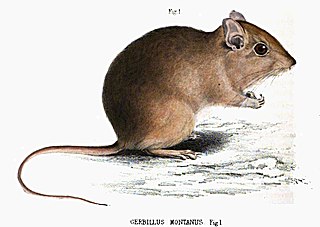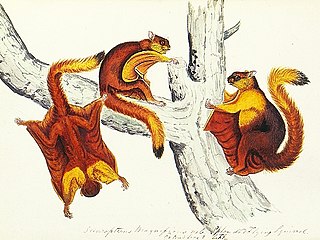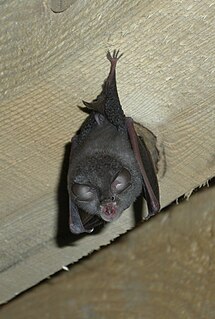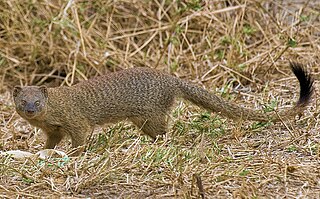 W
WBrandt's hedgehog is a species of desert hedgehog native to parts of the Middle East and Central Asia. Its common name derives from its having first been described by Johann Friedrich von Brandt, a director of the Zoological Department at the St Petersburg Academy of Sciences.
 W
WThe bushveld elephant shrew or bushveld sengi is a species of elephant shrew in the family Macroscelididae. It is found in Angola, Botswana, Namibia, and South Africa. Its natural habitats are subtropical or tropical dry shrubland and hot deserts.
 W
WThe crab-eating mongoose is a mongoose species ranging from the northeastern Indian subcontinent and Southeast Asia to southern China and Taiwan. It is listed as Least Concern on the IUCN Red List.
 W
WBotta's pocket gopher is a pocket gopher native to western North America. It is also known in some sources as valley pocket gopher, particularly in California. Both the specific and common names of this species honor Paul-Émile Botta, a naturalist and archaeologist who collected mammals in California in 1827 and 1828.
 W
WThe hairy-footed gerbil is a species of gerbil found in Angola, Botswana, Mozambique, Namibia, South Africa, and Zimbabwe. Its natural habitats are dry savanna, temperate shrubland, hot deserts, sandy shores, and urban areas.
 W
WThe highveld gerbil is a species of gerbil found in Angola, Botswana, Lesotho, Namibia, South Africa, Eswatini, Zambia, and Zimbabwe. Its natural habitats are dry savanna, temperate shrubland, subtropical or tropical dry shrubland, temperate grassland, and temperate desert. This is a common species with a wide range and the International Union for Conservation of Nature has rated it as being of "least concern" as of 2008.
 W
WThe Hispaniolan hutia is one of several hutia species to have inhabited at some time the island of Hispaniola. P. aedium is the only scientifically confirmed extant species of the genus Plagiodontia, and the only extant species of hutia on Hispaniola; other species are either extinct or being debatedly catalogued as P. aedium subspecies. The name Plagiodontia means "oblique tooth" in Greek.
 W
WHodgson's giant flying squirrel is a species of rodent in the family Sciuridae. This large flying squirrel lives in Himalayan forests in Asia. Like other flying squirrels, it is nocturnal and able to glide long distances between trees by spreading out its patagium, skin between its limbs.
 W
WThe large rufous horseshoe bat is a species of bat in the family Rhinolophidae. It is endemic to the Philippines.
 W
WThe Magellanic tuco-tuco is a species of rodent in the family Ctenomyidae. It is found in Argentina and Chile. Its natural habitat is subtropical or tropical dry lowland grassland. It is also known as the cururo by the Ona culture of Tierra del Fuego.
 W
WThe Mohol bushbaby is a species of primate in the family Galagidae which is native to mesic woodlands of the southern Afrotropics. It is physically very similar to the Senegal bushbaby, and was formerly considered to be its southern race. The two species differ markedly in their biology however, and no hybrids have been recorded in captivity.
 W
WThe numbat is an insectivorous marsupial native to Western Australia and recently re-introduced to fenced reserves in South Australia and New South Wales. The species is also known as the noombat or walpurti. Its diet consists almost exclusively of termites. Once widespread across southern Australia, its range is now restricted to several small colonies and it is considered an endangered species. The numbat is an emblem of Western Australia and protected by conservation programs.
 W
WThe orange-bellied Himalayan squirrel is a species of rodent in the family Sciuridae. It is found in Bangladesh, China, India, Myanmar, Nepal and Bhutan.
 W
WThe particolored flying squirrel is a species of rodent in the family Sciuridae. It is found in Bangladesh, Bhutan, Cambodia, China, India, Laos, Myanmar, Nepal, Thailand, and Vietnam. Its natural habitat is subtropical or tropical dry forests. It is threatened by habitat loss.
 W
WPteropus pelagicus is a species of fruit bat in the family Pteropodidae. It includes two subspecies that were formerly recognized as full species— Pteropus insularis and Pteropus phaeocephalus. It is endemic to Micronesia. It is threatened by habitat loss.
 W
WThe short-eared possum is a species of marsupial in the family Phalangeridae endemic to Australia. Found north of Sydney, the species was once classed as a mountain brushtail possum, which is its closest relative.
 W
WThe short-snouted elephant shrew or short-snouted sengi is a species of elephant shrew in the family Macroscelididae. It is found over a wide area of Africa. Its natural habitats are dry savanna and subtropical or tropical dry lowland grassland.
 W
WThe slender mongoose, also known as the black-tipped mongoose or the black-tailed mongoose, is a very common species of mongoose of sub-Saharan Africa.
 W
WThe small Asian sheath-tailed bat is a species of sac-winged bat in the family Emballonuridae. It is found in Borneo, Sulawesi, and the Philippines.
 W
WSmith's bush squirrel, also known as the yellow-footed squirrel or tree squirrel, is an African bush squirrel which is native to woodlands of the southern Afrotropics.
 W
WThe ursine tree-kangaroo is a species of marsupial in the family Macropodidae. It is endemic to the Vogelkop and possibly the Fakfak Peninsulas, West Papua, Indonesia. Other common names for this species include the black tree-kangaroo, the Vogelkop tree-kangaroo and the white-throated tree-kangaroo. It is threatened by habitat destruction and is listed as "vulnerable" by the International Union for Conservation of Nature.
 W
WThe white-eared titi, Plecturocebus donacophilus, also known as the Bolivian titi or Bolivian gray titi, is a species of titi, a type of New World monkey, from eastern Bolivia and an area of western Brazil. The species has a range that extends east from the Manique River in Beni Department, Bolivia to southern Rondônia in Brazil. The southern end of its range includes forests around the city of Santa Cruz de la Sierra.
 W
WThe white-throated round-eared bat is a South and Central American bat species found from Honduras to Bolivia, Paraguay and Brazil. It creates roosts inside the nests of the termite, Nasutitermes corniger. It thrives on a mainly insect-based diet, focusing on the surfaces of foliage to hunt, and also eats fruit and pollen. It has a very wide range and is a common species over much of that range, so the International Union for Conservation of Nature has assessed its conservation status as being of "least concern".